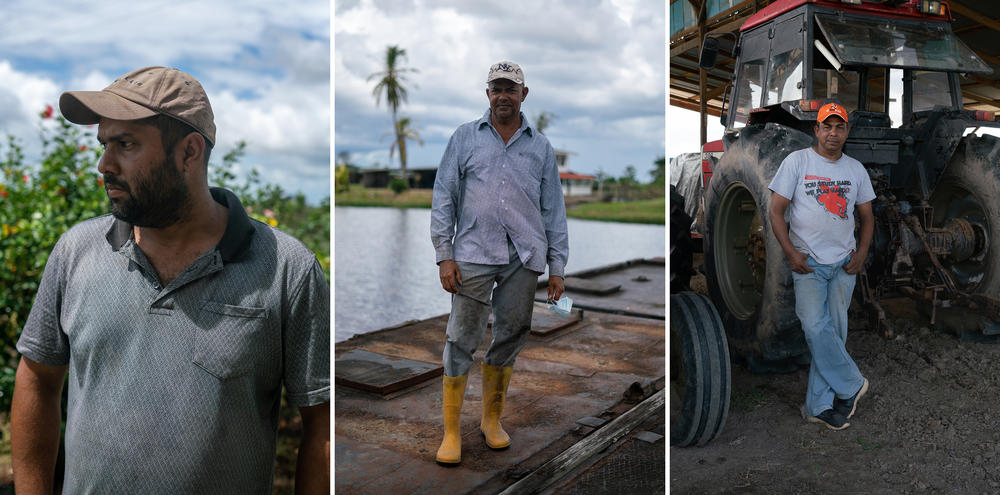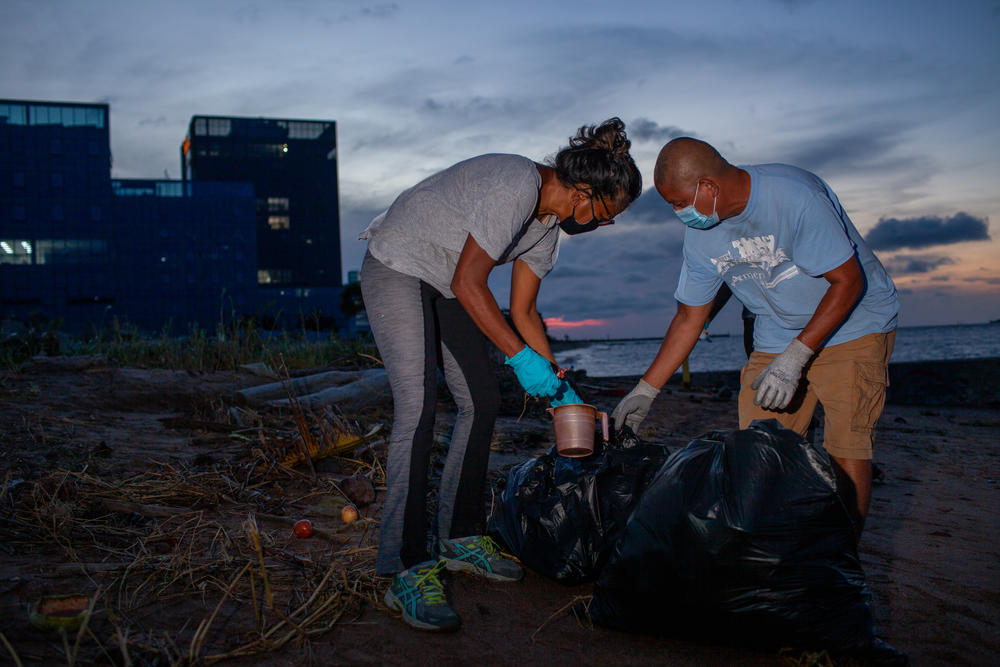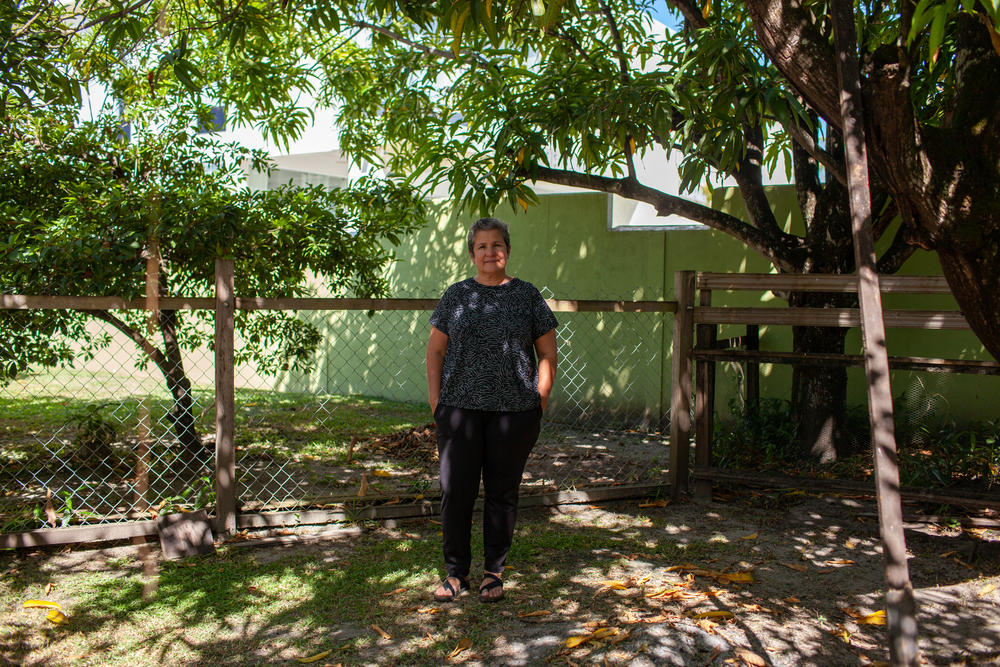Loading...
Section Branding
Header Content
Guyana is a poor country that was a green champion. Then Exxon discovered oil
Primary Content
GEORGETOWN, Guyana – For more than a century, a wide, low seawall has protected the country of Guyana from the depravations of the Atlantic Ocean.
Today, the weathered old seawall is a cheerful place. Vendors sell beer and coconut water, blasting local radio stations as they look out over muddy waters. Kids play, couples flirt. Exhausted workers catch a cool breeze after another 90-degree day in the capital city of Georgetown.
But for climate expert Seon Hamer, standing beneath a wild almond tree next to the wall, the view is not as peaceful as it seems.
"All of this," he says, "could be gone."
Hamer has seen the climate models. In the worst-case scenario, they predict that rising sea levels would eventually reach far inland and this capital city would be completely submerged.
Climate change is causing catastrophes worldwide, but for Guyana, which is one of the poorest countries in South America, the risks are especially existential.
Nonetheless, the country is hitching its future to the same fossil fuels that are accelerating climate change.
A few years ago, ExxonMobil struck oil off Guyana's coast, and it keeps finding more crude. Drillships continue to work just over the horizon, in the direction of Hamer's unsettled gaze.
By the latest estimates, there could be more than 10 billion barrels beneath Guyana's waters, providing a potential windfall to its citizens. That's bigger than Mexico's proven reserves — for a country with a tiny fraction of Mexico's population.
So Guyana is emerging as the world's newest oil producer at a time when world leaders are under pressure to reduce their countries' reliance on oil, coal and natural gas, one of the main objectives at the COP26 talks in Glasgow, Scotland.
The possibility — and perils — of sudden oil wealth
The seawall that stretches along Guyana's coast can be traced back to Dutch colonizers, who reclaimed the low-lying, marshy plains to expand their land.
Guyana later became a British territory (today, it's the only English-speaking country in South America). But Dutch ghosts allegedly still wander their old settlements — and the Dutch decision to reclaim this land from the sea is haunting modern-day residents.
Guyana's Indigenous minority is concentrated far inland, but most of the population, largely descended from enslaved Africans and indentured people from India, live along the coast. Their lands are kept dry through an aging network of drainage canals and a system of sea defenses.
Guyana is under increasingly dire threat: Waters are rising several times faster than the global average, and already, high tides periodically sweep over the top of the seawall, while salt water is contaminating wells near the coast.
The sea is not the only peril.
"We've seen a lot more high-intensity, short-duration rainfall," says Garvin Cummings, the head of Guyana's Hydrometeorological Service.
That shift in rain patterns is overwhelming Guyana's drainage systems, with calamitous results.
It happened again this May, when the country was pounded by days of relentless rains and creeks started to swell.
"We wake up, like, 5 o'clock in the morning and there was the water, rising, rising," says Chandroutie Persaud, who lives in Wash Clothes, a farming community southeast of the capital city, along Mahaicony Creek.
Her family laid boards around inside their home and around their yard, lifting possessions up higher and higher, day after day.
Finally, they declared defeat. Persaud and her husband abandoned the first floor of their home; their son, daughter-in-law and grandchildren moved to a shelter.
Rice fields turned into ponds, deeper than a 6-foot-tall man could stand in. Livestock sickened and died and rotted in the waters. Fruit trees, cultivated carefully for years, drowned. And those waters stayed, not for days or for weeks, but for months — up to four months in some areas.
Four months of getting around by boat, relying on donated food to survive and staring out at the water destroying your livelihood.
"What gone done gone," says Vadim Harikrishna Indarpaul, a contractor and home farmer who lives nearby. "There's nothing we could have saved."
The overwhelming flooding just lasted too long, he says. "It was really cruel to us," he says. "Really, really."
From role model to embracing oil
Guyana's extreme vulnerability to climate change has made it a longtime champion of climate action.
In fact, Guyana is one of very few countries that had been acting as a carbon sink, capturing more emissions than it released, thanks to its remarkable success preserving its lush inland rainforests.
It even struck a deal to get compensated for its work fighting climate change. Norway, an oil-rich country interested in offsetting its own emissions, paid Guyana to conserve forests, and thus capture carbon.
The agreement was groundbreaking and was seen as a potential model for other countries to monetize the battle against climate change.
But now Guyana is trading in its green halo in exchange for something far more profitable: oil revenue.
Companies had long suspected there was oil off Guyana's shores — the country is located right next to oil-rich Venezuela — but no one ever found any.
Then Exxon decided to take a gamble and look in deeper waters. The discovery the company announced in 2015 was extraordinary: One Exxon executive compared it to a "fairy tale." Since then, even more oil has been found in Guyana's waters.
Guyana is determined to develop this oil as fast as it can.
"We have a small window to get as much as possible out," says Bharrat Jagdeo, the country's former president and current vice president — and the head of its delegation to the ongoing COP26 climate talks.
'There's nothing fair in this'
Jagdeo is no climate denier. He was the one, as president, who struck that deal with Norway to get paid for forest carbon.
But he has also embraced the oil industry. And it's no mystery why: For helping to save the planet, Guyana managed to earn about $150 million after more than a decade of work. The oil industry is bringing in twice that per year, and it's just getting started.
It's an awkward time for a country to enter the oil industry. In order to prevent the worst effects of climate change, global oil consumption needs to drop immediately. If that happens, oil investments made today might not be profitable – they could become what's called stranded assets, very expensive and suddenly useless.
Jagdeo, who spoke to NPR before he headed to Glasgow, Scotland, for the current climate talks, is acutely aware of that. He says he supports a rapid end to the oil industry. But he doesn't actually believe the world can pull it off.
"It's not happening, and we don't see that happening any time soon," he says. "I'm not positive that we will see any major shift."
So as global leaders call for the end of oil, Guyana is going the other way, subsidizing large-scale oil investments and preparing to sell crude to a world still addicted to it.
It's an uncomfortable position. But it's not a unique one. Around the world, oil producers and consumers are calling for a shift away from fossil fuels, while still relying on them in vast quantities.
Jagdeo argues that blocking new development would only protect the profits of existing producers such as Saudi Arabia or the U.S. — countries that "will never give us a cent," as Jagdeo puts it.
He points out that in the 2015 Paris Agreement, rich countries promised $100 billion a year to help developing countries tackle climate change. That promise has not been kept.
And countries like Guyana face huge expenses, from raising seawalls to helping farmers prepare for worsening floods.
Guyana didn't turn to oil just because rich countries didn't deliver on their promises — the oil money would have appealed even if the aid had come through.
But, Jagdeo says, the unmet aid pledge makes it particularly frustrating to hear calls for Guyana and other would-be new producers to leave their oil in the ground, while countries such as Saudi Arabia continue to pump and profit.
"There's nothing fair in this," he says.
A bad deal for Guyana?
Jagdeo hopes to wring billions of dollars out of the oil industry and use those funds for Guyana's development and climate adaptation.
The money is substantial. Jagdeo predicts that direct oil revenues to the government will top $1 billion in a few years – more than half the entire national budget – while some analysts predict it could be 10 times higher.
Across the entire economy, Guyana's GDP is already increasing rapidly, and the country's foreign minister has said he expects it to quintuple.
But tying a country's fortunes to oil has always been risky. The sudden infusion of oil cash typically makes a developing country's economy worse, rather than better. It's called the resource curse.
The new wealth can drive corruption and conflict, and a new oil power is positioned for a lot of pain when its big moneymaker experiences one of its periodic price crashes.
There's another concern, too. Guyana's deal with Exxon was unusually favorable for Exxon. The terms were designed to attract exploration from reluctant oil companies at a time when Guyana was seen as a risky bet.
Now that oil has been struck, the sweetheart deal is feeling a little sour. Groups from the International Monetary Fund to the Inter-American Development Bank, as well as think tanks like IEEFA, have all noted elements of the contract that advantage Exxon over the government. And many Guyanese politicians agree the terms are inadequate (though they disagree about who is to blame).
Under the contract, Guyana's share of the revenues are relatively small at first. Over time, they should hypothetically grow to the billions, but it could take years. That delay could be risky, given that the world could manage to rapidly slash its use of oil. And many critics worry that Guyana will struggle to get its fair share of revenue.
"All kinds of games and shenanigans could be played," says Vincent Adams, the former head of Guyana's Environmental Protection Agency. He says his country simply lacks the petroleum expertise to adequately defend its interests against experienced oil giants like Exxon: "We have no way, no way of monitoring and verifying."
ExxonMobil, in a statement to NPR, says the contract's terms are "competitive with other agreements signed in countries at a similar resource-development phase," citing third-party research.
"Our work and the support of the government of Guyana are the basis of a long-term mutually beneficial relationship that has created significant value for the people of Guyana," an Exxon spokesperson wrote.
Doubting, skeptical, but going along
Ordinary Guyanese also have misgivings about the Exxon deal. They agree that Guyana needs money, but many are skeptical that the oil deal will actually benefit them.
"The oil and gas sector doesn't do nothing for Guyana," Avery Sobers, a taxi driver taking a break along the seawall, states flatly. "The money does not come back and spend in this country."
Others are concerned about environmental risks.
"Getting the oil money is now," says Indarpaul, the contractor who spent months living in floodwaters. But once the oil has been drilled, he says, "[if] the country's gone ... the money couldn't fix back the country."
Still, Indarpaul doesn't see that as a reason to stop the drilling entirely. And this ambivalence, falling short of firm opposition, is widespread in Guyana — a murky mix of hope, need and weary cynicism.
Annette Arjoon-Martins is a conservationist and a pilot, with a bird's-eye view of how climate change is affecting Guyana. Already one Indigenous community she's worked with has had to move to higher ground.
She criticizes the oil development for not helping Indigenous Guyanese and for giving too small a share of funds to Guyana. She also thinks Exxon should be doing more to partner with local environmental groups like hers to monitor for damage to ecosystems.
But she doesn't call for a halt to the production.
"Look, if the First World countries would pay us to keep the oil in the ground and compensate us from what we would lose if we didn't extract it, well, that would be the ultimate fix for me as a Guyanese," she says.
But that's not on the table. And Guyana needs the money, Arjoon-Martins says.
Even Seon Hamer, who's haunted by the vision of rising seas, stops short of calling for Guyana to shut down the drilling.
He stands by the seawall, looking out over water filled with sediment carried from deep in the Amazon, and thinks of all the things that oil revenue could pay for. Education and health care. Renewable energy. Sustainable transportation. More resilient agriculture.
Then he sums up the kind of calculation that's being made around the world, in the agonizing clash between the future and the present.
"We have to get funds, basically," he says. "And ... the oil industry would provide a lot of that funds in the near future."
Text by Camila Domonoske. Photos by Ryan Kellman. Tamica Garnett contributed to this report.
Copyright 2021 NPR. To see more, visit https://www.npr.org.

















